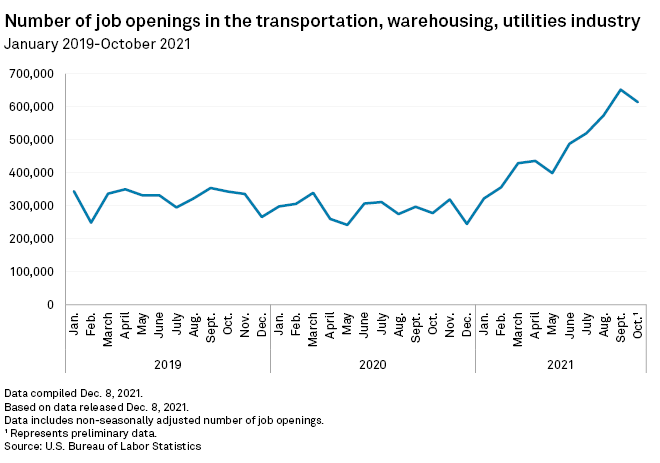S&P Global Offerings
Featured Topics
Featured Products
Events
S&P Global Offerings
Featured Topics
Featured Products
Events
S&P Global Offerings
Featured Topics
Featured Products
Events
Banking & Capital Markets
Economy & Finance
Energy Transition & Sustainability
Technology & Innovation
Podcasts & Newsletters
Banking & Capital Markets
Economy & Finance
Energy Transition & Sustainability
Technology & Innovation
Podcasts & Newsletters
S&P Global Offerings
Featured Topics
Featured Products
Events
13 Dec, 2021
U.S. supply chain woes will worsen in the near term before easing up well into 2022 as bare shelves persist bare and prices rise.
Transportation is the biggest supply-side problem facing businesses as ships wait to unload off the California coast, said Oren Klachkin, lead U.S. economist with forecasting and analytics group Oxford Economics. Warehousing is also backed up, said Joel Naroff, president of consulting firm Naroff Economics. Bottlenecks in both areas must be fixed before there is a significant reduction in supply chain issues, Naroff said.
"With luck, in six months we should have visible progress, but it could take 12 months before major progress or resolution becomes clear," Naroff said in an interview.
Supply chains are still feeling the effects of the pandemic, which forced businesses to shut down or shift production as consumer needs changed. Consumers have had a difficult time finding certain goods throughout the pandemic as products ranging from appliances to cars to lumber and building materials have been out of stock and backordered. Future shortages may include healthcare products and domestic food production, economists said.
Labor has also been in short supply, complicating the recovery picture. The number of job openings in the transportation, warehousing and utilities industry steadily increased throughout 2021, until there was a slight drop in October, according to U.S. Bureau of Labor Statistics data.

Next shortage
Consumer goods are especially hard hit since the U.S. is reliant on overseas production. Companies that use just-in-time inventory with limited suppliers were not prepared for the bottlenecks the pandemic created.
It is difficult to pinpoint where the next shortage will be since almost every sector is experiencing supply chain issues, Klachkin said. A shortage of healthcare and cleaning goods may re-emerge with the news of the omicron variant, although more information about the variant's spread and health impact is needed, he said.
The supply chain of domestic food production could be severely affected, said Lauren Henderson, economic analyst with Stifel. Henderson cited the double-digit increases in energy prices and certain food products such as eggs, pork, and animal feeds in October’s Consumer Price Index report.
Future struggles
Supply-chain bottlenecks are likely to worsen in the near term, Henderson said.
"It will take time for supply chains and the economy to recalibrate back to pre-pandemic patterns," she said in an interview.
President Joe Biden in October announced the California ports of Long Beach and Los Angeles would operate 24/7. While ships might have an easier time finding a spot to unload with 24/7 ports, storage capacity is still limited, Oxford Economics' Klachkin said.
The trucking industry is also having a difficult time keeping up with the influx of foods from the boats amid a driver shortage, and about 75% of goods are transported across the U.S. via truck, Klachkin said.
Even if the transportation issues ease, supply chain stress might not fall so quickly, Oxford Economics' Klachkin said.
"The current environment will persist for quite some time, and it's important to remember that U.S. conditions are also reliant on developments overseas," he said, adding that the omicron variant could impede progress.
Gift cards?
All of this has already impacted holiday shopping as companies place orders in the summer and fall, and it will endure as consumers face empty shelves at stores, Klachkin said.
Labor and supply shortages are also driving up prices with inflation hitting a 30-year high, Stifel's Henderson said. Out-of-stock products increased in stores and online leading up to Thanksgiving and Black Friday, she said.
"Shortages of materials and labor due to supply-chain bottlenecks and … pandemic-related policies, respectively, are expected to negatively impact consumers as they head to retailers and shop online this holiday season," Henderson said.
Naroff said he received holiday cards in late January last time, but this season it might be presents that arrive late as last-minute shoppers are in for an even bigger shock than they have experienced previously.
"Maybe gift cards will be the big thing again this year," Naroff said.

